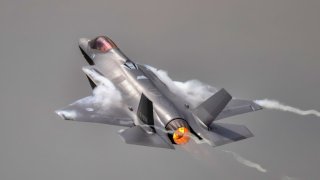Iron Fist 24: How Japan and America are Training for War with China
Training events like Iron Fist are an excellent opportunity to showcase the U.S. and Japanese militaries' capabilities in the event of a conflict in the Indo-Pacific with China.
In February and March, the U.S. Marine Corps joined the Japanese military for Iron Fist 24, an annual military exercise that showcases U.S.-Japanese military coordination.
Iron Fist
The America Ready Group conducted joint training operations with both the Japan Ground Self-Defense Forces and Japan Maritime Self-Defense Forces.
During the exercise, the America Amphibious Ready Group conducted maritime and flight operations with Japanese aircraft and warships. In terms of specific capabilities trained, the two forces worked on Visit, Board, Search, and Seizure (VBSS) operations—boarding and capturing enemy or suspect vessels at sea.
“Sailors assigned to the America Amphibious Ready Group (ARG), and Marines assigned to the 31st Marine Expeditionary Unit, celebrated the completion of the 18th iteration of Exercise Iron Fist, alongside members of the Japan Ground Self-Defense Force (JGSDF) and Japan Maritime Self-Defense Force (JMSDF), in a ceremony held on the flight deck of the JMSDF Ōsumi-class tank landing ship JS Kunisaki (LST-4003), March 17,” the Navy stated.
The goal of the annual Iron Fist exercise is to increase the interoperability between the two military forces and create a better joint force.
“Exercises like this present a great opportunity for growth and integration,” Capt. Kelly Fletcher, the commodore of Amphibious Squadron (PHIBRON) 11, said in a press release.
“Iron Fist was a success because over the course of the exercise, we have shared best practices, learned from one another, and sharpened our collective swords to improve our ability to conduct combined amphibious operations,” Fletcher added.
The Japanese Military
Japan is an important U.S. ally in a very sensitive geopolitical region. Situated near North Korea and China, Japan would be critical in the event of a U.S. conflict with either. In terms of capabilities, the Japanese military has been getting increasingly stronger and possesses substantial air and naval power.
When it comes to air power, the Japanese military fields 200 F-15J/DJ Eagle fighter jets and thirty-four F-35A/B Lighting II stealth fighter jets (with 123 more on order). However, the Japanese military also brings to the table important anti-submarine warfare capabilities with its 103 P-3 Orion and Kawasaki P-1 aircraft. The Indo-Pacific’s vast expanses are ideal for naval warfare, and submarines would play a big part. Thus, having a robust capability dedicated to finding enemy subs would be a great resource in the event of a conflict.
As far as naval power, the Japanese military brings to the table important capabilities, including forty-two guided-missile destroyers and escort destroyers, twenty-three attack submarines, twenty-two minesweepers, eighteen landing ships and crafts, four replenishment ships, four light aircraft carriers (officially called helicopter destroyers), and four multi-purpose frigates (FREMM).
Training events like Iron Fist are an excellent opportunity to combine the above capabilities with those of the U.S. military and be ready to act as one in the event of a conflict in the Indo-Pacific.
About the Author
Stavros Atlamazoglou is a seasoned defense and national security journalist specializing in special operations. A Hellenic Army veteran (national service with the 575th Marine Battalion and Army HQ), he holds a BA from the Johns Hopkins University, an MA from the Johns Hopkins’ School of Advanced International Studies (SAIS), and is pursuing a J.D. at Boston College Law School. His work has been featured in Business Insider, Sandboxx, and SOFREP.
Image: Shutterstock.com


